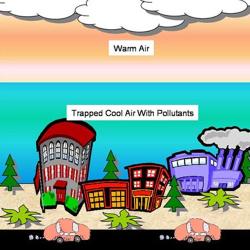Source Institutions
Add to list Go to activity
Activity link broken? See if it's at the internet archive

Learners see convection currents in action in this highly visual demonstration. Sealed bags of colored hot or cold water are immersed in tanks of water. When the bags are punctured with pinholes, colored water is allowed to flow through the larger quantity of water. This is one of three demonstrations investigating convection currents and their effects on weather and air pollution. Resource contains vocabulary definitions and suggestions for assessment, extensions, and scaling for different levels of learners.
- 5 to 10 minutes
- 10 to 30 minutes
- 1 cent - $1 per group of students
- Ages 8 - 14
- Activity, Demonstration
- English
Quick Guide
Materials List (per group of students)
- 2 aquariums (or very large glass jars/beakers)
- 2 small plastic bags with strong seals
- Dark-colored food coloring
- Bowl (to mix water, ice and food coloring)
- 1 long straight pin
- 1 long-handled spoon or ladle
- Water
- Ice cubes
- Hot plate/microwave/stove (optional; required only if tap water is not hot enough)
- Pan or cooking container (optional; to heat water on hot plate/microwave/stove)
Subjects
-
Earth and Space Science
-
Earth Processes
- Weather and Climate
-
Earth Structure
- Atmosphere
-
Earth Processes
-
Engineering and Technology
-
Engineering
- Civil Engineering
- Environmental Engineering
-
Engineering
-
Life Sciences
-
Ecology
- Human Impact
-
Ecology
-
Physical Sciences
-
States of Matter
- Gases
-
Structure and Properties of Matter
- Mass and Weight
- Volume and Density
-
States of Matter
Audience
To use this activity, learners need to:
- see
- touch
Learning styles supported:
- Involves hands-on or lab activities
Other
Includes alignment to state and/or national standards:
This resource is part of:
Access Rights:
- Free access
By:
- Kolenbrander, Amy ; Yowell, Janet ; Mach, Natalie ; Schaefer Zarske, Malinda ; Carlson, Denise ; Kotys-Schwartz, Daria
Source Collection
- TeachEngineering
Rights:
- All rights reserved, Regents of the University of Colorado, 2004
Funding Sources:
- Fund for the Improvement of Postsecondary Education (FIPSE)
- U.S. Department of Education
- National Science Foundation, 0226322
